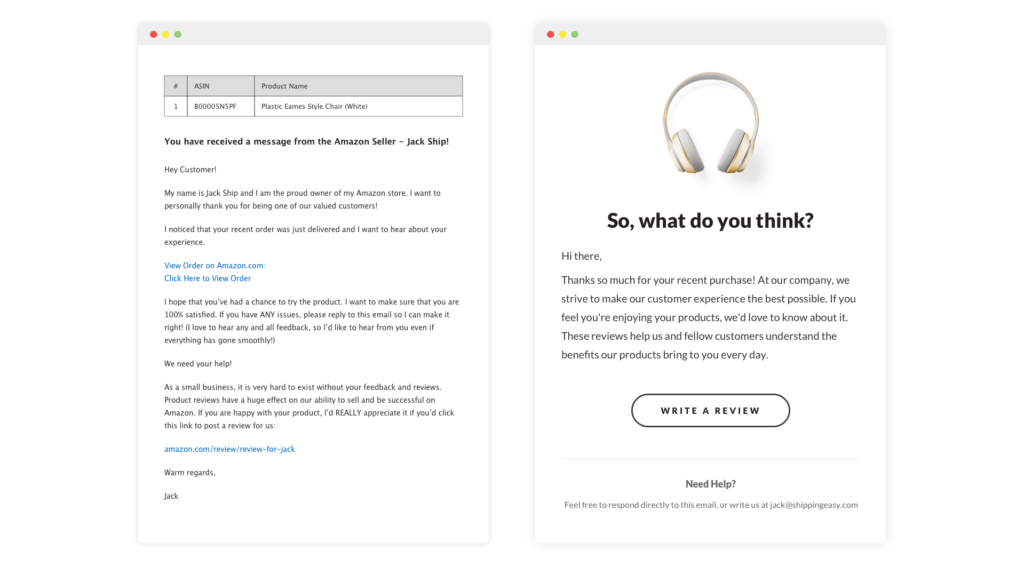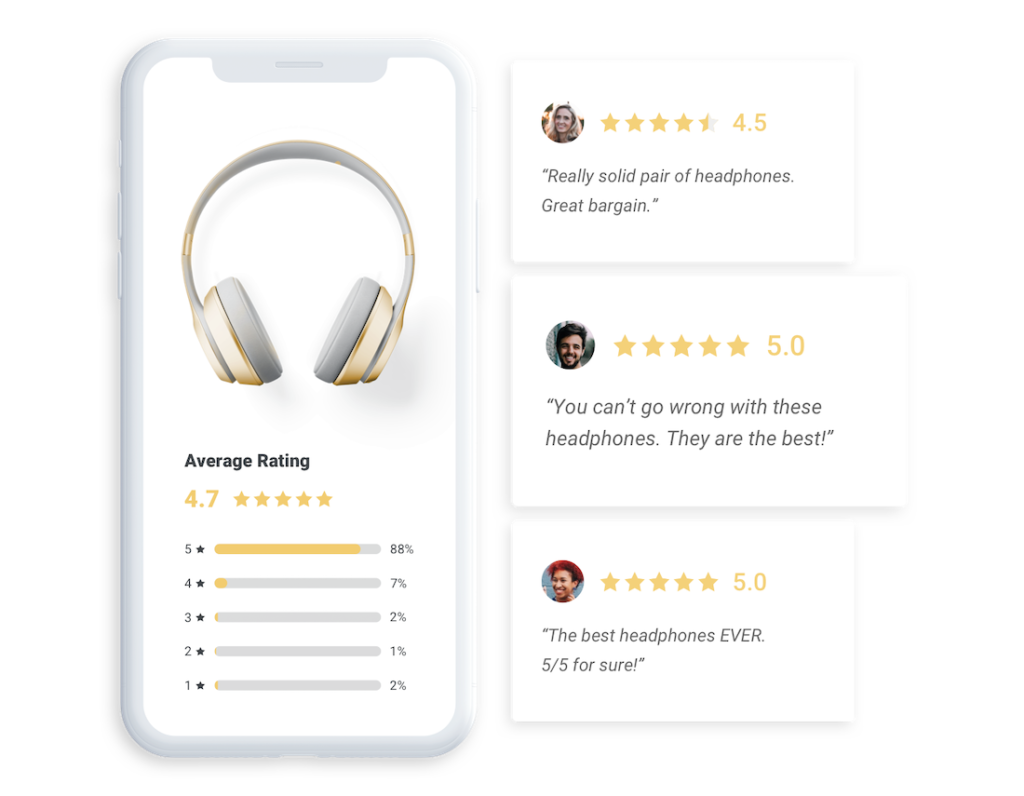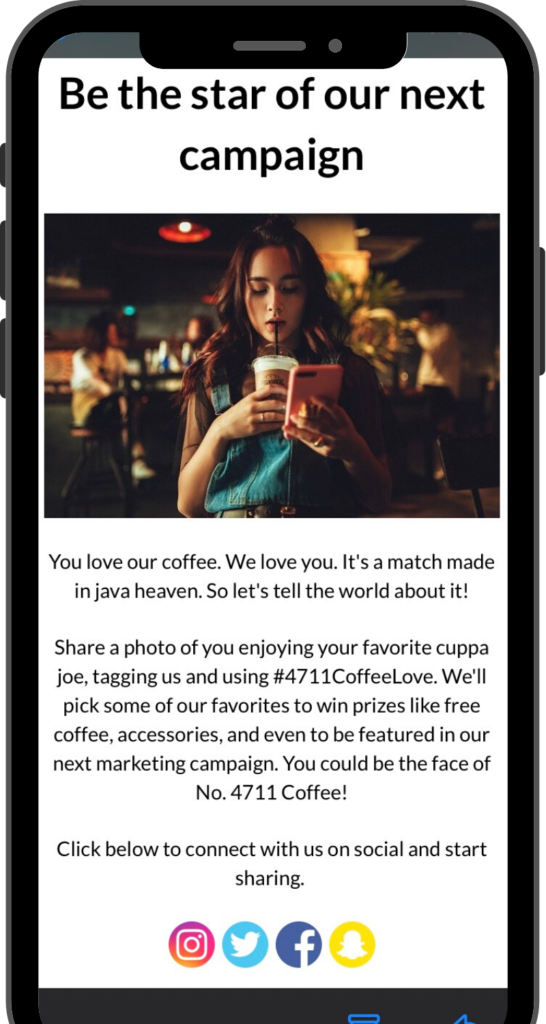You may have heard the term user-generated content, but perhaps aren’t quite sure how it applies to your e-commerce business. People trust the input and experiences of their peers. When real humans are sharing their experiences with products and services, other people pt more stock into that content than anything your brand could create. Every e-commerce business should have a user-generated content strategy, as it is one of the best ways to build an audience of interested buyers while simultaneously continuing to engage your current customers.
User-Generated Content Strategy: Reviews
In e-commerce, reviews are the lifeblood of success. When 72% of customers say they don’t take action until after they’ve consulted reviews, this form of user-generated content is something that can’t be ignored.
Rather than simply taking a reactionary approach to customer reviews, have a user-generated content strategy based around eliciting them. This way, you’re not waiting on reviews and hoping they’ll be written by the happy customers. You can take an active part in eliciting responses from the customers who have the best things to say about your products and services. The best part is that it doesn’t have to be a manual process!
Automated reviews campaigns
No e-commerce merchant has time to send emails one-by-one to every customer who has purchased from them. When it comes to requesting reviews, timing can be just as important as the way you ask. Too soon and people may not have had enough time with the product (or may not have even received it yet!). Too late and they may have already moved on, leaving you feeling like you completely missed your window of opportunity.
When you have customer data, order data, and delivery data, you can set up automated triggers to send emails at just the right time. Do your customers likely open the product and use it immediately? Send an email asking them to share their feedback the next day. Is it something they need to use a few times before they’d be able to formulate an opinion? Set a scheduled send a week or two after the item was delivered to give them time to know just how great your product is.

Just be sure to use a friendly outreach, personalizing wherever possible. Don’t use long paragraphs and blocks of text. Get right to your point. Incorporate a product image to remind them what they bought and what you’re asking about, and give a clear call to action that leads them directly to where they can leave a review for the specific product or for your business, whichever you’re trying to achieve.
Amazon feedback campaigns
Amazon feedback campaigns can be a bit trickier as part of your user-generated content strategy. The rules Amazon puts in place when it comes to contacting your customers are strict and can come with harsh penalties if violated.
That being said, Amazon users are generally some of the web’s most review-centric users, so you want to make sure you’re focusing dedicated efforts to build your reputation on the platform.
Want a few success tips? See how a 7-figure Amazon seller wins on Amazon.
There are also specific rules you need to follow when requesting Amazon reviews from your customers, such as:
- Don’t offer discounts of gift cards for reviews
- Don’t ask for specific star-ratings, but rather honest reviews
- Don’t offer refunds or credits for writing reviews
For a full list of the rules, visit Amazon Seller Central.

User-Generated Content Strategy: Social Content
Organic reach just isn’t what it used to be for most brands on social media. Gone are the days of putting a post up on your page and watching likes and comments roll in, putting your post in front of the eyes of all the friends and family of your followers. But all hope is not lost, especially when you’re implementing a solid user-generated content strategy that activates your customers to speak on your behalf!
Encourage customers to share
What’s better than a photo of your products shared on your social pages by you? A photo or video of a real customer using your product in real life, shared by them! Now sure, you could wait around for them to share something and like it, repost it (with permission, more on that in a sec), and comment on it. Or, you could set up email campaigns to actively encourage people to share to social!

To get the most out of these campaigns, you’ll likely want to segment and create some messaging that caters to each audience a bit. Sending an email to someone who just purchased from you for the first time, asking them to tell the world about you may not yield the best results. Someone who has been a loyal customer for the past year, however, could be highly successful.
In your customer list, or in Customer Marketing if you’re a ShippingEasy customer, segment a customer list of those who’ve shopped from you numerous times this year or who have spent the highest amount with you. Create an email like the above, which I did in a matter of minutes using our Customer Marketing tool’s drag-and-drop editor, and send it to your segmented list with a subject line like “We want to feature VIP customers like you!” Watch for customers to tag you and be sure to follow your hashtag on all appropriate social channels to start collecting a library of photos and videos featuring real customers using your products.
Privacy and permission
Though initiatives like this can be a wildly successful part of your user-generated content strategy, you need to make sure you cover all your legal bases. This means getting explicit permission from your customers before you use any of their content in your campaigns.
Check with each social platform you want to encourage people to share to and be aware of their contest rules. You may need to require that people include #Promotion or #Contest or #Sweepstakes in order to stay within guidelines. You will likely also need to include verbiage in the Official Rules that the social channels are in no way sponsoring or affiliated with your contest.
Some platforms require that you run sweepstakes, which means winners are chosen at random, rather than contests, where judges choose winners. Depending on the geography of your demographic, you may also need to make sure you have a process for removing any personally identifying information you collect so you’re compliant with GDPR (UK residents) and CCPA (California residents). The vast majority of the time, none of this will come up and your customers will be excited to be featured on your social channels, ads, and in future email campaigns. Just be sure to offer transparency in how you plan to use their content and you should be okay.
User-Generated Content Strategy: Word-of-Mouth
This can be a little more difficult to track, but still holds weight when it comes to increasing sales, particularly for businesses with physical locations. People trust reviews almost as much as in-person recommendations, which means in-person recommendations hold the most weight. But how can you make encouraging word-of-mouth part of your user-generated content strategy?
Much like the social media strategy, you need to offer customers some form of encouragement. One of the best ways to do this is through a loyalty program. There are numerous software solutions available to retailers to help them create branded loyalty programs. Below are a few of the top-rates ones, according to Software Advice:
- Qualtrics CustomerXM
- TapMango
- Kangaroo
- NiceJob
- Fivestars
People love earning rewards for spreading the word about products and services they love. Something they also love, particularly the Millennials generation (as mentioned in our loyalty article above), is being able to give back. You might try offering a loyalty program where their referrals lead to donations on your part to your customers’ favorite charities. This not only builds goodwill but can also tie you into the local community, which in turn continues to build word-of-mouth.
However you plan to build your user-generated content strategy, email is one of the best ways to get the information out to your customer base. ShippingEasy’s Customer Marketing platform helps you do that, while also sending automated emails based on triggers that are crucial to building repeat business in e-commerce.
Give the platform a try for 30 days to see how easy it can be to connect with your customers and grow your business!
Rob Zaleski
Latest posts by Rob Zaleski (see all)
- USPS 2023 Shipping Rate Changes - November 16, 2023
